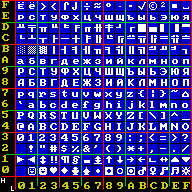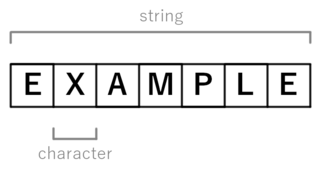Related Research Articles

In computing and electronic systems, binary-coded decimal (BCD) is a class of binary encodings of decimal numbers where each digit is represented by a fixed number of bits, usually four or eight. Sometimes, special bit patterns are used for a sign or other indications.

In computing, floating-point arithmetic (FP) is arithmetic that represents subsets of real numbers using an integer with a fixed precision, called the significand, scaled by an integer exponent of a fixed base. Numbers of this form are called floating-point numbers. For example, 12.345 is a floating-point number in base ten with five digits of precision:
In mathematics and computing, the hexadecimal numeral system is a positional numeral system that represents numbers using a radix (base) of sixteen. Unlike the decimal system representing numbers using ten symbols, hexadecimal uses sixteen distinct symbols, most often the symbols "0"–"9" to represent values 0 to 9, and "A"–"F" to represent values from ten to fifteen.

In computing, a nibble (occasionally nybble, nyble, or nybl to match the spelling of byte) is a four-bit aggregation, or half an octet. It is also known as half-byte or tetrade. In a networking or telecommunication context, the nibble is often called a semi-octet, quadbit, or quartet. A nibble has sixteen (24) possible values. A nibble can be represented by a single hexadecimal digit (0–F) and called a hex digit.
Octal is a numeral system with eight as the base.

In computer programming, a string is traditionally a sequence of characters, either as a literal constant or as some kind of variable. The latter may allow its elements to be mutated and the length changed, or it may be fixed. A string is generally considered as a data type and is often implemented as an array data structure of bytes that stores a sequence of elements, typically characters, using some character encoding. String may also denote more general arrays or other sequence data types and structures.
A computer number format is the internal representation of numeric values in digital device hardware and software, such as in programmable computers and calculators. Numerical values are stored as groupings of bits, such as bytes and words. The encoding between numerical values and bit patterns is chosen for convenience of the operation of the computer; the encoding used by the computer's instruction set generally requires conversion for external use, such as for printing and display. Different types of processors may have different internal representations of numerical values and different conventions are used for integer and real numbers. Most calculations are carried out with number formats that fit into a processor register, but some software systems allow representation of arbitrarily large numbers using multiple words of memory.
Double-precision floating-point format is a floating-point number format, usually occupying 64 bits in computer memory; it represents a wide dynamic range of numeric values by using a floating radix point.
In computer programming, a bitwise operation operates on a bit string, a bit array or a binary numeral at the level of its individual bits. It is a fast and simple action, basic to the higher-level arithmetic operations and directly supported by the processor. Most bitwise operations are presented as two-operand instructions where the result replaces one of the input operands.
In computer science, primitive data types are a set of basic data types from which all other data types are constructed. Specifically it often refers to the limited set of data representations in use by a particular processor, which all compiled programs must use. Most processors support a similar set of primitive data types, although the specific representations vary. More generally, "primitive data types" may refer to the standard data types built into a programming language. Data types which are not primitive are referred to as derived or composite.

A power of two is a number of the form 2n where n is an integer, that is, the result of exponentiation with number two as the base and integer n as the exponent. If n is negative, 2n is called an negative power of two or inverse power of two.
In computing, fixed-point is a method of representing fractional (non-integer) numbers by storing a fixed number of digits of their fractional part. Dollar amounts, for example, are often stored with exactly two fractional digits, representing the cents. More generally, the term may refer to representing fractional values as integer multiples of some fixed small unit, e.g. a fractional amount of hours as an integer multiple of ten-minute intervals. Fixed-point number representation is often contrasted to the more complicated and computationally demanding floating-point representation.

The syntax of the C programming language is the set of rules governing writing of software in C. It is designed to allow for programs that are extremely terse, have a close relationship with the resulting object code, and yet provide relatively high-level data abstraction. C was the first widely successful high-level language for portable operating-system development.
In computing, a word is the natural unit of data used by a particular processor design. A word is a fixed-sized datum handled as a unit by the instruction set or the hardware of the processor. The number of bits or digits in a word is an important characteristic of any specific processor design or computer architecture.

In computer programming, an integer overflow occurs when an arithmetic operation attempts to create a numeric value that is outside of the range that can be represented with a given number of digits – either higher than the maximum or lower than the minimum representable value.
In the C programming language, data types constitute the semantics and characteristics of storage of data elements. They are expressed in the language syntax in form of declarations for memory locations or variables. Data types also determine the types of operations or methods of processing of data elements.
A bit field is a data structure that consists of one or more adjacent bits which have been allocated for specific purposes, so that any single bit or group of bits within the structure can be set or inspected. A bit field is most commonly used to represent integral types of known, fixed bit-width, such as single-bit Booleans.
In computing, bit numbering is the convention used to identify the bit positions in a binary number.
This article compares a large number of programming languages by tabulating their data types, their expression, statement, and declaration syntax, and some common operating-system interfaces.
In computer science, an integer literal is a kind of literal for an integer whose value is directly represented in source code. For example, in the assignment statement x = 1, the string 1 is an integer literal indicating the value 1, while in the statement x = 0x10 the string 0x10 is an integer literal indicating the value 16, which is represented by 10 in hexadecimal.
References
- ↑ Cheever, Eric. "Representation of numbers". Swarthmore College. Retrieved 2011-09-11.
- ↑ Madhusudhan Konda (2011-09-02). "A look at Java 7's new features - O'Reilly Radar". Radar.oreilly.com. Retrieved 2013-10-15.
- ↑ Barr, Adam (2018-10-23). The Problem with Software: Why Smart Engineers Write Bad Code. MIT Press. ISBN 978-0-262-34821-8.
- ↑ "Sybase Adaptive Server Enterprise 15.5: Exact Numeric Datatypes".
- ↑ "MySQL 5.6 Numeric Datatypes".
- ↑ "BigInteger (Java Platform SE 6)". Oracle. Retrieved 2011-09-11.
- 1 2 3 4 5 Fog, Agner (2010-02-16). "Calling conventions for different C++ compilers and operating systems: Chapter 3, Data Representation" (PDF). Retrieved 2010-08-30.
- ↑ Thorsten Leemhuis (2011-09-13). "Kernel Log: x32 ABI gets around 64-bit drawbacks". www.h-online.com. Archived from the original on 28 October 2011. Retrieved 2011-11-01.
- ↑ Giguere, Eric (1987-12-18). "The ANSI Standard: A Summary for the C Programmer" . Retrieved 2010-09-04.
- 1 2 Meyers, Randy (2000-12-01). "The New C: Integers in C99, Part 1". drdobbs.com. Retrieved 2010-09-04.
- 1 2 3 4 "ISO/IEC 9899:201x" (PDF). open-std.org. section 6.2.6.2, paragraph 2. Retrieved 2016-06-20.
- 1 2 3 "ISO/IEC 9899:201x" (PDF). open-std.org. section 5.2.4.2.1. Retrieved 2016-06-20.
- ↑ "Fundamental types in C++". cppreference.com. Retrieved 5 December 2010.
- ↑ "Chapter 8.6.2 on page 12" (PDF). ecma-international.org.
- ↑ VB 6.0 help file
- ↑ "The Integer, Long, and Byte Data Types (VBA)". microsoft.com. Retrieved 2006-12-19.
- ↑ Giguere, Eric (December 18, 1987). "The ANSI Standard: A Summary for the C Programmer" . Retrieved 2010-09-04.
- ↑ "American National Standard Programming Language C specifies the syntax and semantics of programs written in the C programming language". Archived from the original on 2010-08-22. Retrieved 2010-09-04.
- ↑ ECMAScript 6th Edition draft: https://people.mozilla.org/~jorendorff/es6-draft.html#sec-literals-numeric-literals Archived 2013-12-16 at the Wayback Machine